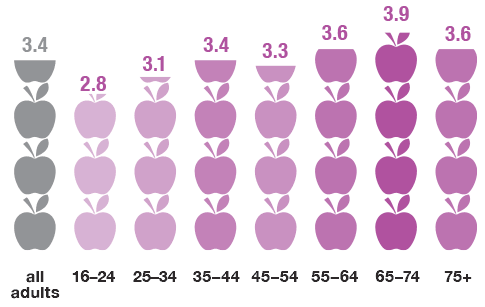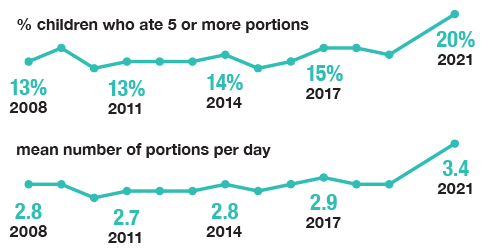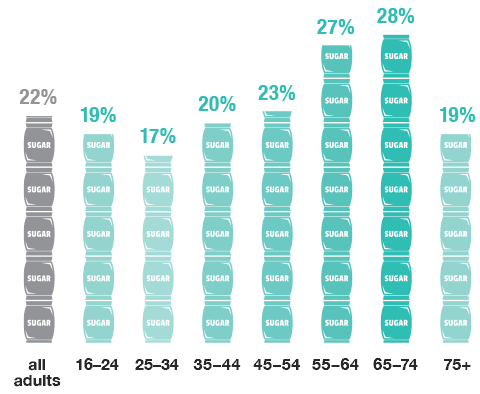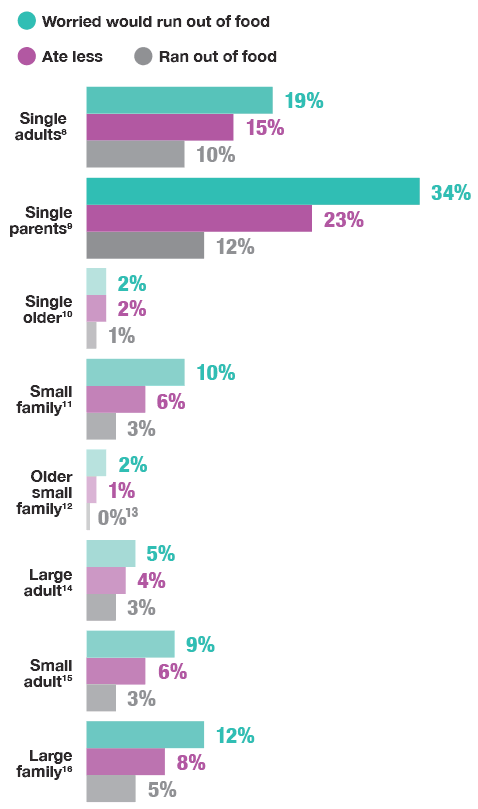The Scottish Health Survey 2021: summary report
Key findings from the Scottish Health Survey 2021 report.
Chapter 4 Diet and Food Insecurity
In 2021, the proportion of adults who consumed 5 or more portions of fruit and vegetables per day was the same as in 2019 and fairly stable since 20031.

Fruit and vegetable consumption (mean number of portions per day) was lowest for those aged 16-24 and highest for those aged 65-74.

In 2021, the proportion of children aged 2-15 who consumed 5 or more portions of fruit and vegetables and the average daily consumption was significantly higher than in any of the years 2008 to 20192.

In 2021, the average energy intake per person per day was significantly higher for men than for women.
women
1,495 kcal/day
men
1,786 kcal/day
all adults
1,632 kcal/day
Energy intake (kcal/day) varied by age; highest for those aged 35-44 and lowest for those aged 65 and above.

In 2021, one in five adults met the energy density3 Scottish Dietary Goal (SDG) of no more than 125 kcal/100g/day, with women more likely to do so than men.
20% of adults
16% of men
24% of women
In 2021, almost half of all adults met the SDG for total fat intake4, while only a quarter met the SDG for saturated fat intake5.
48% Total fat intake
26% Saturated fat intake
In 2021, just over a fifth of adults met the SDG for free sugars intake6, with adults aged 55-74 being the most likely to do so.

Nearly three quarters of adults in 2021 consumed no more than 70g of red and red processed meat per day. Women were more likely than men to consume no more than 70g per day.
72% All adults
64% Men
79% Women
In 2021, a very low proportion of adults met the SDG for fibre intake7, with men being more likely than women to do so.
6% All adults
8% Men
5% Women
Across all adults in 2021, a lack of money or other resources in the previous 12 months resulted in:
9% worried about running out of food
6% ate less
3% ran out of food
In 2021, younger adults were more likely to be worried that they would run out of food.
14% 16-44
8% 45-64
1% 65+
In 2019/2021 combined, the highest levels of food insecurity were among single parents and single adults under the age of 65.

Footnotes
1 Figures for 2021 have been calculated from data collected as part of the Intake24 dietary recalls. Data from earlier years was taken from the Scottish Health Survey fruit and vegetable module.
2 The changes from face-to-face (in previous years) to telephone interviewing (in 2021) may have affected the time series.
3 Energy density of food is generally higher for foods rich in fat and sugar, and lower for starchy carbohydrates, fruits and vegetables.
4 The SDG is for average intake of total fat to reduce to no more than 35% of food energy. Food energy does not include energy from alcohol.
5 The SDG is for average intake of saturated fat to reduce to no more than 11% of food energy. Food energy does not include energy from alcohol.
6 The SDG is that average intake of free sugars does not exceed 5% of total energy. Total energy includes energy from alcohol.
7 The SDG is for an increase in average consumption of AOAC (Association of Analytical Chemists) fibre to 30g/day.
8 One adult aged 16-64, no children.
9 One adult any age and one or more children. It should be noted that the definition of a single parent does not make any distinction between situations where a child has regular contact and/or partly resides with their other parent and a child who solely resides with and is cared for by one parent.
10 One adult aged 65 and over, no children.
11 Two adults of any age and one or two children.
12 One adult under 65 and one adult 65 and over or two adults 65 and over, no children.
13 0 non-zero values of less than 0.5% and thus rounded to zero.
14 Three or more adults, no children.
15 Two adults under 65, no children.
16 Two adults of any age and three or more children or three or more adults and one or more children.
Contact
There is a problem
Thanks for your feedback